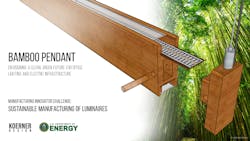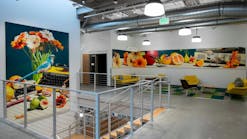DOE awards Koerner Design for sustainable LED luminaires design competition
The US Department of Energy (DOE) has announced the winner of its Manufacturing Innovator Challenge for Sustainable Manufacturing of Luminaires. Brad Koerner of Koerner Design won the award in the program hosted by the DOE Office of Energy Efficiency and Renewable Energy (EERE). Koerner’s winning design is a bamboo pendant that relies on recycled materials, a minimal bill of materials, and delivers excellent energy efficiency.
The DOE launched the challenge back in October, saying that most solid-state lighting (SSL) products rely on materials such as aluminum and other dense materials. The announcement noted that LED sources should be amenable to lighter-weight designs and materials that could be easily recycled at the end of life. Meanwhile, the program sought concepts that delivered excellent efficiency and light quality at the system level.
Koerner has long championed the circular economy and new approaches to luminaire design. In the entry to the DOE contest, he said, “Pushing the lighting industry to completely rethink our ambitions for sustainable and circular economy products and solutions has been a personal focus of mine for many years. The LED revolution turned entire lighting fixtures into disposable, e-waste junk. We took a model that worked great for decades — replaceable and repairable sockets and lamps — and completely threw it away in the name of LED thermal efficacy and cost reduction.”
Way back in 2013, Koerner made a presentation at Strategies in Light arguing for a change in luminaire design where final assembly and customization of LED luminaires could take place on building sites and where modular light engines would be utilized. And he also wrote a column for us after challenging the DOE to encourage new sustainable approaches, perhaps in part leading to a contest that he ultimately won.
Koerner’s concept for the DOE contest is fully revealed on his website. His intention was a design that would enable net-zero buildings. He proposed a centralized power conversion and a DC grid to maximize electrical efficiency — a topic we have covered a number of times.
The design is based around LEDs mounted on a flax-based printed-circuit board (PCB) rather than the fiberglass and epoxy resins used widely by the electronics and lighting industries. Koerner’s contest entry stated that, at end of light, the PCB could compost back into the flax fields that supplied the raw materials to make the PCBs.
Koerner chose bamboo to build the structural elements of the luminaire. He said bamboo is a rapidly renewing resource that does not require a lot of energy or processing before being integrated into a luminaire. And the result has quite a compelling look and feel.
Even the methodology for assembling Koerner’s bamboo luminaire was developed to promote sustainability. The pieces fit together almost like a 3-D puzzle, avoiding adhesives and screws. And even the low-voltage cables enabled by DC power were specified to be free of any toxic substances.
In the end, the DOE felt that the best luminaire designs would both reduce the number of parts used and the manufacturing cost of a luminaire. Koerner’s Bamboo Pendant offers the potential of meeting that goal, delivering state-of-the-art energy efficiency, and providing excellent light quality.





